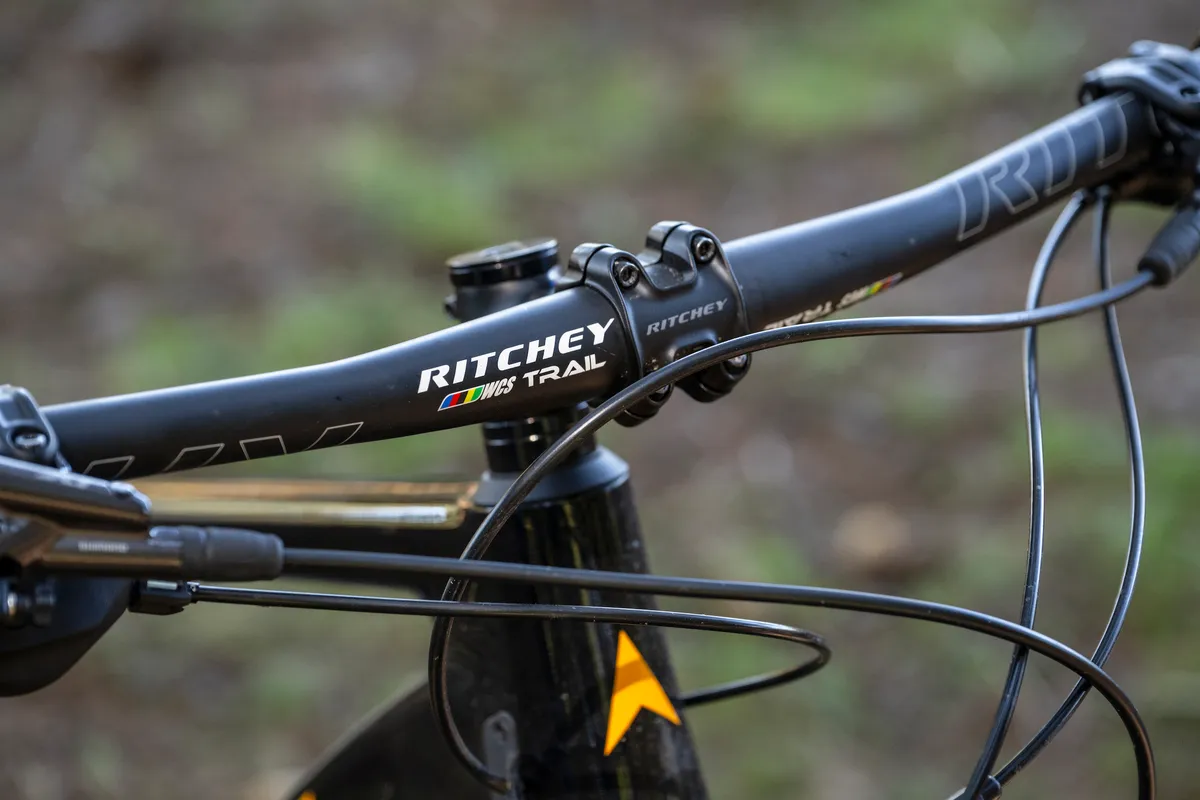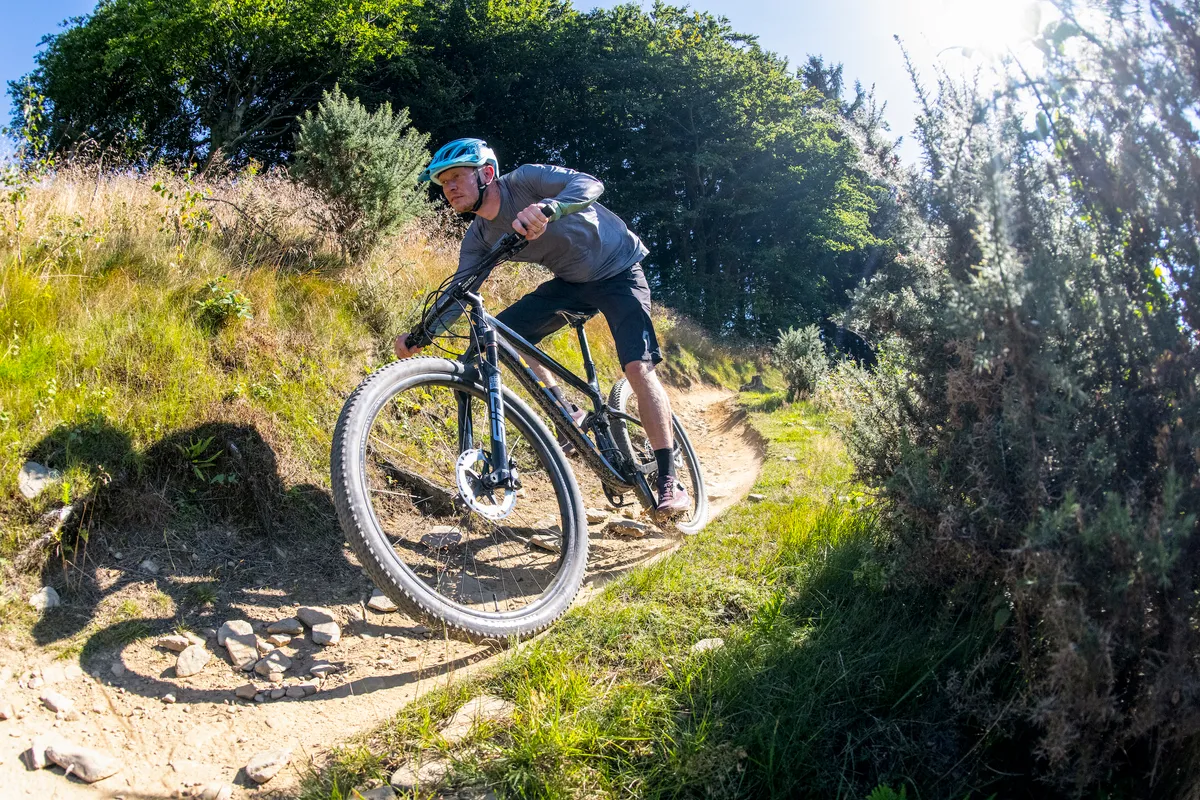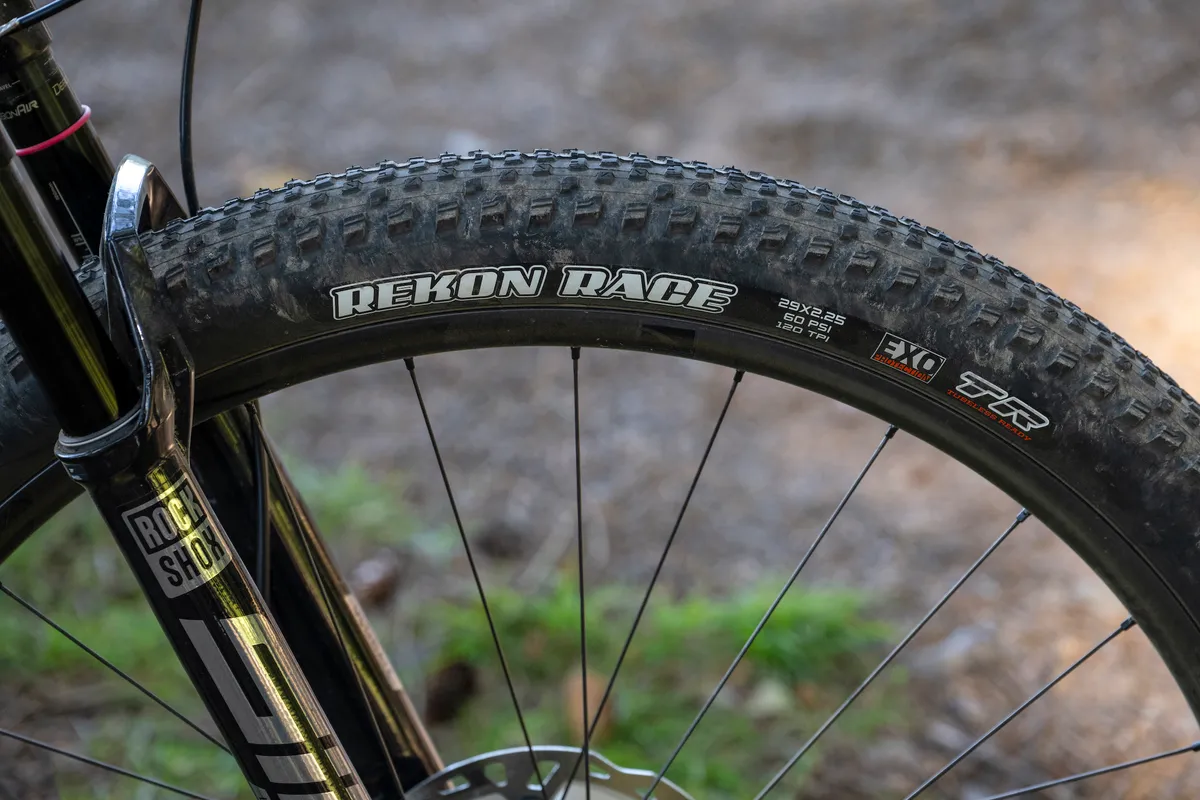The Vitus Rapide FS full-suspension mountain bike is designed for the challenges posed by modern cross-country course designers, favouring increasingly technical race routes to push the limits of riders and bikes.
Steeper climbs, rougher descents and gnarlier features all require cross-country bikes that can handle a bit of rough.
As such, Vitus has given the 100mm-travel Rapide a modern shape, with aggressive angles and perhaps the longest reach on the race scene.
As ever with Vitus, this is blended with some high-spec parts.
So, does it all link up seamlessly on the trail?
Vitus Rapide FS CRX frame details

Vitus has built the frame from a unidirectional carbon fibre, with front and rear triangles constructed from the material.
Though Vitus describes the suspension as a 4-bar linkage, it’s really a flexstay design, with the rear triangle not featuring a physical pivot between the chainstays and seatstays. Instead, flex is built into the rear triangle to mimic the action of a rear pivot.
The main pivot sits just behind the chainring, with the front portion of the driveside chainstay being protected from chain suck via a small metal plate.
The seatstays, which feature a svelte bridge at the top and are flattened slightly shortly after they leave the rear-axle area, push on a rocker linkage that compresses the shock. The bottom of this sits bolted to the front triangle just ahead of and above the bottom bracket.

There's a bit of a well underneath the shock, giving room for the shock's adjusters. However, I noticed it becomes a water and mud trap – something to be aware of.
Inside the frame is a single bottle cage mount – some marathon racers may prefer a design that allows for two bottle cages.
Cables run internally, popping out of the top-side of the down tube, ahead of the shock, before looping over the main pivot and dropping into the chainstays.

The entry and exit ports on the front triangle feature a bolt-in slotted plate to guide the hoses. I found the derailleur outer cable could start rubbing on the shock and seat tube if the loop had been pulled too tight from the rear of the bike.
However, routing at the front of the bike is very neat, with no cable rub to report on the head tube.
In a world of headset-routed cabling, it's nice to see an XC bike with simple internal cable routing.
Vitus Rapide FS CRX geometry
Vitus hasn't been shy when proportioning the Rapide FS, with geometry that takes plenty of inspiration from much longer-travel rigs.
The headline figures are the 500mm reach (size large) – longer than most enduro bikes – and 67-degree head angle, which is slack for XC. This is paired with a steep 77-degree effective seat angle.
Chainstays are moderately long, at 438mm, while the bottom bracket is slung low under the axles, with a drop of 45mm.
My only gripe is that the 490mm seat tube length, on my size-large test bike, is pretty long. If you want to make the bike even more rad and fit one of the best dropper posts, you might find yourself limited to shorter-drop models.
| | Small | Medium | Large | XL |
|---|---|---|---|---|
| Seat tube length (mm) | 410 | 440 | 490 | 540 |
| Effective top tube length (mm) | 578 | 612 | 640 | 664 |
| Reach (mm) | 445 | 475 | 500 | 520 |
| Stack (mm) | 583 | 592 | 606 | 624 |
| Chainstay length (mm) | 438 | 438 | 438 | 438 |
| Head tube length (mm) | 95 | 105 | 120 | 140 |
| Head tube angle (degrees) | 67 | 67 | 67 | 67 |
| Seat tube angle (degrees) | 77 | 77 | 77 | 77 |
| Bottom Bracket drop (mm) | 45 | 45 | 45 | 45 |
| Wheelbase (mm) | 1,159 | 1,193 | 1,224 | 1,251 |
Vitus Rapide FS CRX specifications

The specification of the bike represents excellent value for money.
On top of the carbon frame, you get a 100mm RockShox SID SL Ultimate – the brand's lightest XC fork. This is paired with a Select+ SIDLuxe shock. Both are linked to an on-bar lockout lever.

Shimano provides the stop and go. There's a largely XT drivetrain, though thoughtfully Vitus has upgraded the shifter to an XTR model. Shimano's two-piston XT brakes feature too.
My test bike was fitted with an XTR rear derailleur, but checking Vitus' website reveals the CRX Rapide now has an SLX model.
The chainset comes with a 32t ring, though I suspect some XC racers would prefer a 34t. Crank arms are 175mm on all but the size-small bike, which gets 170mm cranks.

On paper, the Reynolds TR 309/289 XC Carbon Wheelset looks great. The wheels have a relatively deep rim, which in my experience can catch crosswinds a little more than most mountain bike wheels. The freehub's 10-degree pick-up is fast, though.
The wheels are wrapped in Maxxis Rekon Race tyres in a 2.25in width. Though, with the Reynolds rims being pretty wide, they feel as though they blow up with a larger volume than their dimensions suggest.
Finishing kit comes largely from the Ritchey WCS line, with bar, stem and seatpost all alloy. The saddle is a WTB SL8 Comp.

Vitus Rapide FS CRX ride impressions
The Rapide was tested largely on my home XC trails in Bristol and South Wales. However, the bike also spent some time with my colleague Alex Evans up in Scotland's Tweed Valley.
I rode the Rapide on my usual XC test tracks, and included longer marathon-style rides, with shorter, punchier XC blasts.
Vitus Rapide FS CRX climbing performance

At 11.4kg, the Rapide isn't the lightest XC bike, however other than at the real sharp end of XC racing, I don't think this matters too much.
The slight extra weight is masked by the fast-rolling Maxxis Rekon Race tyres.
They have a shallow, closely packed tread that emits only a high-pitched hum on smooth surfaces, posing minimal drag when you're pushing hard along tarmac and fire road climbs. Their supple sidewalls also aid rolling resistance, while boosting traction and comfort along the way.
During testing, I ended up with the rear suspension at around 22 per cent sag after a bit of experimentation.
With this setup, the suspension bobs a bit on smooth tracks, and here I used the bar-mounted lockout for fork and shock.

The suspension on some XC bikes feels very taught when under power. However, the Rapide's rear end is at the supple end of the spectrum, especially when compared to solid-feeling bikes such as the Orbea Oiz.
With an easily accessible lockout, though, I wasn't too concerned. I probably used the lockout more on the Vitus than I would on some other XC bikes (including the Oiz and the Cannondale Scalpel).
The payback, on the climbs, is plenty of traction when the surface is loose and scrabbly. Despite the fast-rolling tread, the Rapide climbs technical sections well.
This is also aided by the geometry.
The seat angle is steep, which both helps to centre your weight between the wheels and puts your hips nicely over the cranks.
With this, I found the Rapide climbs technical sections well. There's ample fore and aft room over the bike to easily move your body weight in order to balance rear-wheel traction with front-wheel accuracy.

The low bottom bracket caused some pedal strikes on technical climbs, especially when attacking the climbs.
Shimano's shifting when under pressure is smooth and accurate in my experience.
Vitus Rapide FS CRX descending performance

It should be no surprise that with a reach of 500mm and a 67-degree head angle, the Rapide is, as its name suggests, rapid on descents.
The long front end of the bike, with its slack head angle, is roomy, composed and confident. It pulls your weight forward over the front wheel, where it can be pushed into the trail to maximise the grip available from the tyres.
The Rekon Race doesn't have an aggressive tread, though. On hardpack and dry trails, this is okay. The slight shoulder tread digs in and gives surprising levels of cornering grip. However, in UK conditions, I'd rather fit a slightly chunkier front tyre, to really make the most of the Vitus' shape.
Likewise, I'd be tempted to fit a shorter stem. On my size-large bike, there was a 90mm stem (though smaller bikes get shorter stems). Doing so would sharpen handling a touch, and with the front-end length being generous, wouldn't leave the bike feeling cramped.
I'd fit a wider bar, too – the 760mm bar on my bike felt a touch narrow on really technical tracks and a wider alternative would give me a little more leverage.

The RockShox SID SL fork at the front is excellent.
The air spring and damping combine to give excellent levels of control. While the 32mm chassis isn't as stiff as the (non-SL) SID or Fox's 34SC fork found on the Giant Anthem and Orbea Oiz, it's still stout enough to cope with all but the hardest or heaviest XC racers, in my opinion.
At the back, the suspension performs well, too.
It's supple, dealing with high-frequency, low-amplitude chatter well, smoothing the way in a comfortable manner. Get the power down, and the bike doesn't feel overly soggy or wasteful of your pedal inputs either, other than the normal bob you'd associate with a comfortable, rather than aggressive, rear XC setup.
It also appears to ramp up nicely towards the end of the stroke. Even on rides when I was running 25 per cent sag, more than I typically would on an XC bike, I rarely bottomed out the shock. When I did, it was rare that the bike offered up any complaints.
This is good, because it gives you more confidence to hit technical tracks, hard.
There are some issues, though.
I felt that the Reynolds wheels were too stiff, transmitting a lot of feedback through the bars, and leading to hand pain on longer rides. This is something Alex also experienced, and a feature of the wheels I've felt previously elsewhere.

The thin grips also offer up little in the way of comfort.
While premium carbon wheels are nice to have, I'd argue a more comfortable wheelset is beneficial on marathon rides.
That said, the wheels are stiff, and the freehub pickup is great, aiding accelerations and a snappy feel.
Vitus Rapide FS CRX bottom line

Overall, I've come away incredibly impressed by the Rapide.
If you like super-stiff, punchy XC bikes where the rear suspension feels solid until it's really needed, it might not be for you.
However, remain seated and the Rapide picks up speed well, and if you do need to get a little more spirited over the pedals, a quick push of the lockout lever sorts out unwanted bob.

On the descents, the geometry and suspension combine to give an incredibly assured and controlled ride. With a tweak to the tyre specs, and perhaps the bar width, it's a great technical descender – add a dropper post (internal routing is an option) for even more downhill fun.
The spec is, as mentioned, excellent for the money. The frame is smart, suspension components top-spec and the mostly XT drivetrain functions well.
The wheels are the only issue in my eyes, being harsher than some. However, swapping the grips and adding a softer, wider bar may well mitigate this.
Product
| Brand | Vitus |
| Price | £3999.99 |
| Weight | 11.44kg |
Features
| Fork | RockShox SID SL Ultimate |
| Stem | Ritchey WCS C220 84D |
| Chain | Shimano XT |
| Frame | Rapide FS UD Carbon Full Suspension Frame |
| Tyres | Maxxis Rekon Race |
| Brakes | Shimano XT |
| Cranks | Shimano XT |
| Saddle | WTB SL8 Comp |
| Wheels | Reynolds TR 309/289 XC Carbon Wheelset |
| Shifter | Shimano XTR |
| Cassette | Shimano XT |
| Seatpost | Ritchey WCS Zero |
| Grips/tape | Vitus Lock On |
| Handlebar | Ritchey WCS Flat Bar |
| Rear shock | RockShox SIDLuxe Select+ |
| Bottom bracket | Shimano |
| Available sizes | S, M, L, XL |
| Rear derailleur | Shimano XT |

